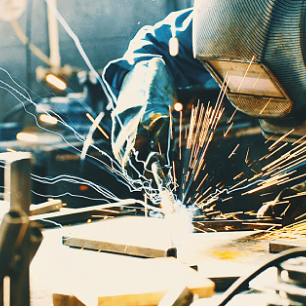Jump to:
The Answer Is
Q: We’re welding stainless pipe and getting sugaring on the inside diameter. We are tigging the root, and like everyone else, we’re using argon for the shielding gas. It is an open root, so no backing ring is involved. We’re purging the inside diameter with argon, but we are still seeing sugaring there. The customer is concerned that the molecules are being disrupted and the material is no longer stainless. What is the story?
A: First, what’s this tigging you’re speaking of?
Next, you are welding stainless steel, so my question is, what type of stainless steel? There are several families. We have the ferritic stainless steel that contains more than 11% chromium. It is ferromagnetic and corrosion resistant. The crystalline structure is body-centered cubic at room temperature and contains insufficient carbon to respond strongly to quenching.
We have martensitic stainless steel, which is similar to ferritic stainless steel. It contains at least 11% chromium but has more carbon than the ferritic stainless steel. It is hardenable when cooled quickly, and some are air-hardenable. When hardened, the crystalline structure is body-centered tetragonal (shaped like a shoe box). It, too, is ferromagnetic.
The third family is used extensively by industry: austenitic stainless steel. It contains at least 11% chromium and enough nickel additions to retain the face-centered cubic crystalline structure at room temperature. Generally, austenitic stainless steel is not strongly magnetic, doesn’t contain sufficient carbon to respond to quenching, and can form some martensite when cold worked. It is noted for its good ductility, slightly higher strength over low-carbon steel, and good corrosion resistance.
Duplex stainless steel has a crystalline structure containing both body-centered cubic and face-centered microstructures at room temperature. It is stronger than austenitic stainless steel and more resistant to sensitization when welded. That means, if it is welded following the proper procedure, it is less prone to intergranular stress corrosion and cracking. Alas, if you don’t weld it properly, you can end up with some Sigma phase, which makes it somewhat brittle. And all those good properties? Well, suffice to say the outcome isn’t pretty.
Then, there is the precipitation-hardened stainless steel that is hardenable when heated to a high temperature, forcing the alloying constituents to go into solution, and then it is quenched. This creates a supersaturated state with the alloying constituents. We’re not done yet; we have to heat it to a low temperature to trigger precipitation. The response is more of a clumping action where some of the alloying constituents form small clumps within the atomic lattice, thereby distorting the lattice. That, in turn, increases the strength of the alloy system. Once again, if the proper welding procedure isn’t followed, the clumped alloys will precipitate to the grain boundaries, thereby weakening the affected region. One secret to successful welding is to order the precipitation stainless steel in the annealed condition so it can be formed, welded, and heat treated to produce optimum strength.
The common feature of all stainless steels is their improved corrosion resistance compared to carbon and high-strength low-alloy steels. Chromium provides corrosion resistance through a mechanism called passivity, which is the ability to form chromium oxides when the alloy is exposed to oxygen. If the protective oxide layer is disturbed, chromium immediately oxidizes to provide corrosion resistance.
Passivation is not the same as the property of passivity. The element in austenitic stainless steel that offers very little in the way of promoting corrosion resistance is iron. So, passivation is a process where the surface of the austenitic stainless steel is treated with an acid to remove the iron from the exposed surface, leaving a very thin (a couple of Angstroms) layer of chrome and nickel that improves the corrosion resistance of the metal. This thin layer can be easily damaged, destroying the benefit of the passivation process.
In a nutshell, to retain the superior corrosion resistance of stainless steel, we have to protect the surface from conditions that could prevent the clean formation of chromium oxide. Thus, we need to protect the surface of the stainless steel while welding it. The side of the joint we’re welding on is protected from excessive oxidation by the argon used as our shielding gas to protect the molten weld pool. If one is welding with the shielded metal arc, submerged arc, or flux cored arc welding processes, the slag layer protects the molten weld pool, as does the CO2.
On the inside of the pipe or the opposite side of the sheet or thin plate, there is little in the way of a protective barrier. The absence of an effective barrier allows the hot metal to become severely oxidized.
Isn’t it the chromium oxide that gives us the passivity (i.e., the corrosion resistance of stainless steel) we want?
You hit the nail on the head. The hot chromium is exposed to oxygen, and it does oxidize. In a dry environment, all is good. The chemistry of the underlying alloy is not affected; it is still what it was before welding, and the mechanical properties are still what they were. The problem arises when the piping is placed into service and a liquid that is considered an electrolyte is introduced into the pipe. The base metal that wasn’t heated to a high temperature is what it always was: stainless steel with a thin, clear, protective layer of chromium oxide. However, the surfaces exposed to the high temperature of welding and oxygen are heavily oxidized, but they are composed mainly of chromium oxide, nickel oxide, and iron oxide. The oxide doesn’t have the same chemical composition as the oxide coating of the unaffected base metal. Therein lies the problem.
The issue is galvanic corrosion. Two different metals in the presence of an electrolyte create a battery — that’s right, a battery that produces electricity. The voltage potential between the unaffected base metal and the heavily oxidized root surface is the source of our corrosion problem.
I’ve performed demonstrations for welders and inspectors in which I fill several plastic cups with salt water (or vinegar and water) and then take welding filler metal, one of carbon steel or austenitic stainless steel and the other aluminum wire, connect them with wire to form several voltaic cells in series, and successfully light up an LED. Remember the potato or lemon battery you made in science class back in grade school? It's the same thing here.
The purpose of purging the inside of a pipe while we weld it is to protect the root from oxidation while we deposit the root bead and the second (maybe even the third) layer of the weld. The idea is to have the inside surface of the pipe (or the opposite side of the weld joint) protected from oxidation so that both the inside of the pipe and the root bead have the same degree of oxidation. If the oxidation level is the same for the inside surface of the root bead and pipe, no galvanic action results when an electrolyte is introduced.
The secret is to reduce the oxygen level to prevent excessive oxidation while welding. This is true with other metals besides stainless steel, such as titanium, zirconium, etc. Still, those are reactive metals whose mechanical properties are adversely affected if they are exposed to even small amounts of oxygen while welding, so proper purging is absolutely necessary when welding them.
How do we ensure the level of oxygen is low enough to prevent oxidation (sugaring or decarbonizing in less-trained circles)?
We have to displace the air inside the pipe. Air comprises both nitrogen and oxygen in the proportions of about 80% nitrogen and 20% oxygen. Generally, the open ends of a pipe spool are blocked off with tape or plugs. Enough argon is fed into the pipe to displace the air, reducing the oxygen to a level low enough to prevent oxidation. Argon is heavier (more dense) than air, so the argon settles toward the bottom of the pipe and displaces the air upward. Only if it was this easy. The truth of the matter is that argon and air are going to mix. It has something to do with Charles Dalton and a few other notable men of years gone by who were messing around with gases in their spare time. So, assuming the gases will thoroughly mix, we can estimate how many times we have to displace the air volume in the pipe spool to reduce the oxygen to a tolerable level (see the table below).
Let’s assume there is 20% oxygen inside the pipe spool. We displace the air volume by 1, and the percentage of oxygen is reduced to 10%. Once again, we displace the volume of gas in the pipe spool; the rate of oxygen is 5%. Displace again and oxygen is down to 2.5%; again, 1.25%; again, 0.625%; again, 0.31%; and so on. This assumes complete mixing of the gases with no leakage (because we taped the joints).
Let’s play with this a bit. The math is not that hard. Let’s start with a 6-in. pipe that is 10 ft long. We want to calculate how long we need to purge the pipe spool using argon at a specified flow.
Let’s assume we set the flow meter on the argon tank used for the purge to 20 ft3/h.
It is easy enough to figure out how many hours of argon flow is required to sufficiently reduce the oxygen level if we know the volume of the pipe spool. Then, we multiply the hours by 60 to get the minutes of flow needed.
Let’s try an example:
6-in. pipe: 3-in. radius (never mind the wall thickness, it isn’t significant)
Area of I.D.: Area = πr2 or 32 × 3.1416 = 28.27 in.2 ≈ 29 in.2
Volume: V = Area × length, where the length of the spool is 10 ft = 120 in.
So, V = A × L = 29 × L = 29 in.2 × 120 in. = 3480 in.3.
Convert cubic inches to cubic feet: 3480 in.3/123 = 2 ft3.
To reduce the oxygen to no more than 0.25%, we need to displace the volume of the pipe spool by a factor of 7 times.
7 × 2 = 14 ft3 of argon. At a flow rate of 20 ft3/h, 14/20 = 0.7 hours.
Convert hours to minutes: 0.7 h × 60 min/h = 42 min of purge time.
That calculation did not consider any gas leakage at the joints. Lesson: Tape all the weld joints except the one you are welding. Peel the tape from the joint you are welding as you progress around the joint.
Remember, argon is heavier than air, but we assume gases are mixed thoroughly, so you need to allow the air/argon mixture to escape at the highest point. A small hole in the end of the pipe spool is usually all that is needed to allow the air/argon mixture to exhaust. If you want to get fancy, use a Magnehelic® gauge (pressure differential gauge) to balance the gas pressure inside the pipe with the atmospheric pressure outside the pipe.
Now that the oxygen level in the pipe is at an acceptable level, it is advisable to reduce the flow rate of the argon to simply replace any argon lost through leakage and maintain a slight positive pressure to prevent air from being drawn into the pipe. For pipe diameters up to 4 or 5 in., 5 ft3/h sounds right. Let’s not forget that one must increase the flow rate of the purge gas to account for higher leakage rates when there are several unwelded joints in the spool.
Some of the problems I’ve seen are as follows:
1) The welder didn’t close off the ends of the pipe spool. The welder stuffed the argon hose into an open end and thought that was all they needed to do.
2) The system was not vented; the pipe ends were sealed with plastic plugs, but the plugs kept blowing out. The welder didn’t understand why they kept blowing out.
3) The spool was vented at the high point, but the purge gas flow rate was too high. As the welder made the root pass, the molten weld pool blew out (not the same as a melt-through), leaving a big hole through the root as they were about to close the weld.
4) The pipe spool had several joints, each with a 1/16-in. root opening. The welder didn’t tape the open root joints. They couldn’t understand why the root was “sugared” (oxidized). I pointed out that a single joint in the 4-in. pipe with a 1/16-in. root opening represented a hole measuring 1/16 × 12 in. or the same size as a hole measuring 1 × ¾ in. The ¼-in. hose they used to purge the spool couldn’t keep up with the volume of argon leaking out of each joint.
5) Insufficient flow time. The welder set the flow meter and immediately started to weld their first root.
Since the goal is to deposit a weld with a clean root surface (i.e., no discoloration), don’t forget to clean the inside diameter of the pipe. It has nothing to do with gas purging, but it doesn’t hurt to remind ourselves that the base metal surface has to be cleaned inside and out to get the high-quality weld we strive for. It’s another of those problems I’ve seen several times.
What I’ve described is a way of approximating the time and flow needed to reduce oxygen levels for commercial work and is usually good enough for many jobs. When all is said and done, paying attention to details does pay dividends. If one is working on high-purity or sanitary piping, an oxygen meter is essential to accurately measure the oxygen level in the pipe.
ALBERT J. MOORE JR. (amoore999@comcast.net) is owner of NAVSEA Solutions, Burlington, Conn. He is an AWS Senior Certified Welding Inspector and an ASNT NDT Level III. He is also a NOCTI certified welding instructor.
The Society is not responsible for any statements made or opinions expressed herein. Data and information developed by the authors are for specific informational purposes only and are not intended for use without independent, substantiating investigation on the part of potential users.


